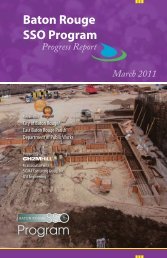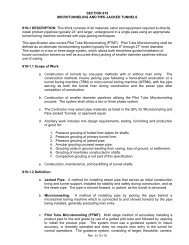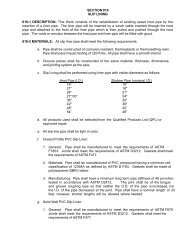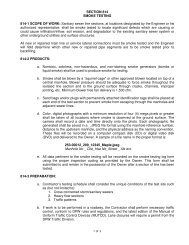Contents
Construction Management Plan - Baton Rouge Department of Public ...
Construction Management Plan - Baton Rouge Department of Public ...
- No tags were found...
You also want an ePaper? Increase the reach of your titles
YUMPU automatically turns print PDFs into web optimized ePapers that Google loves.
• Personnel must not use pan and skeleton metal stairs until permanent or temporary treads and<br />
landings are provided the full width and depth of each step and landing.<br />
• Ladders must be inspected by a competent person for visible defects prior to each day’s use.<br />
Defective ladders must be tagged and removed from service.<br />
• Ladders must be used only for the purpose for which they were designed and shall not be<br />
loaded beyond their rated capacity.<br />
• Only one person at a time shall climb on or work from an individual ladder.<br />
• User must face the ladder when climbing; keep belt buckle between side rails<br />
• Ladders shall not be moved, shifted, or extended while in use.<br />
• User must use both hands to climb; use rope to raise and lower equipment and materials<br />
• Straight and extension ladders must be tied off to prevent displacement<br />
• Ladders that may be displaced by work activities or traffic must be secured or barricaded<br />
• Portable ladders must extend at least 3 feet above landing surface<br />
• Straight and extension ladders must be positioned at such an angle that the ladder base to the<br />
wall is one-fourth of the working length of the ladder<br />
• Stepladders are to be used in the fully opened and locked position<br />
• Users are not to stand on the top two steps of a stepladder; nor are users to sit on top or straddle<br />
a stepladder<br />
• Fixed ladders > 24 feet in height must be provided with fall protection devices.<br />
• Fall protection should be considered when working from extension, straight, or fixed ladders<br />
greater than six feet from lower levels and both hands are needed to perform the work, or when<br />
reaching or working outside of the plane of ladder side rails.<br />
2.2.25 Ultraviolet Radiation<br />
(Reference CH2M HILL SOP HSE-217, Ultraviolet Radiation)<br />
• Sunlight is the most intense source of Ultraviolet Radiation (UV). Welding operations may<br />
produce levels of UV radiation that can result in significant health effects, primarily to the eyes<br />
(see SOP HSE-314, Welding and Cutting).<br />
• Health effects caused by UV radiation are confined to the eyes and skin.<br />
• Overexposure to the skin can result in redness, sunburn, skin rash, premature skin aging, and<br />
numerous types of skin cancer (melanoma is the most serious type of skin caner, and accounts<br />
for 75% of skin cancer deaths).<br />
• Overexposure to the eyes may lead to inflammation of the cornea (sunburn to the cornea, also<br />
known as snow blindness, which leads to redness and a gritty feeling which progresses to pain<br />
and an inability to tolerate any kind of light). Working around or in water, or other natural UV<br />
reflectors, can cause a combination of direct and reflected sunlight resulting in double exposure.<br />
Long-term exposure to sunlight may also cause cataracts or clouding of the lens of the eye.<br />
• UV exposure can lead to skin cancer, premature aging of the skin, wrinkles, cataracts, and other<br />
eye problems. See a health care physician if you find an unusual skin change (spot on the skin<br />
changing in size, shape or color over a period of 1 month to 2 years).<br />
• The amount of UV exposure depends on:<br />
1. The strength of the light;<br />
A-28 GNV310133632156.DOC/090840008












